Centre of Revival
By Mahnoor M. Farooqui | Arts & Culture | Published 7 years ago
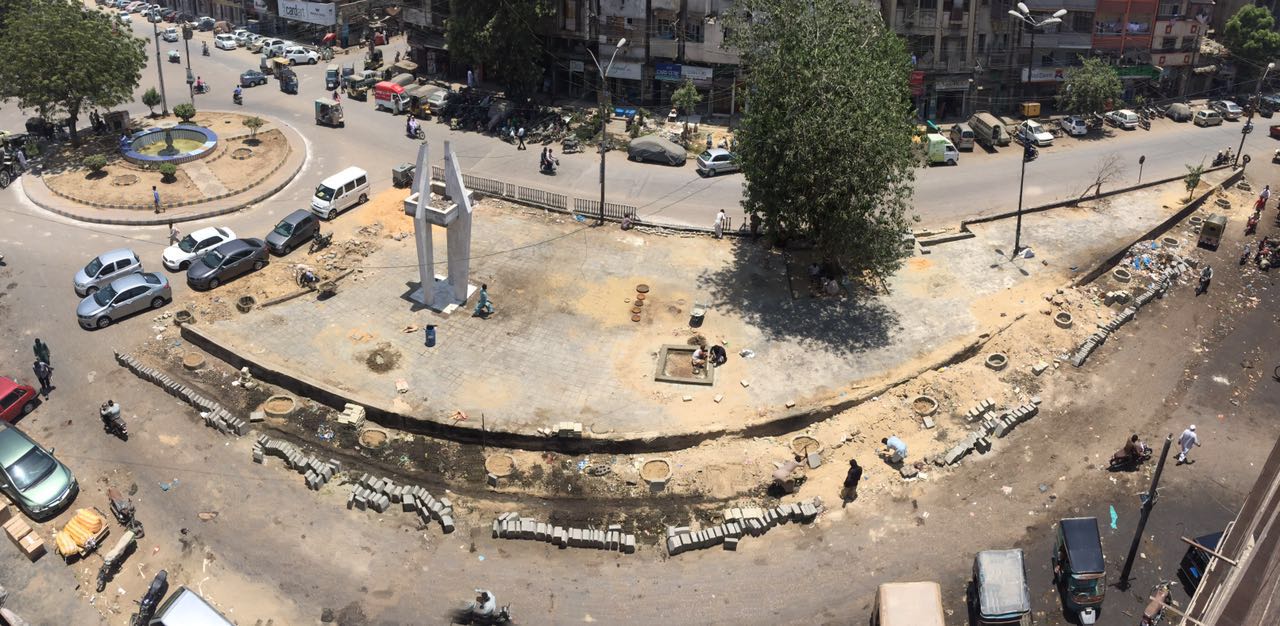
The Pakistan Chowk Community Centre (PCCC) is the perfect example of making the most out of what you have — and then some. Located no more than 20 feet away from Pakistan Chowk, on the first floor of the Sultani Mehal building, the Chowk was meant to be a communal space for the purpose of celebrating art, education and culture, along with generating civil society discourse. By aiming to embody these very qualities, the Community Centre is a living reminder of a time when Pakistan Chowk was the ‘educational heart’ and cultural hub of Karachi.
Tucked between a money transfer shop and a card-printing store, the vibrant two-roomed community space has an out-of-the-box happy interior: rich turquoise furniture and doors, deep red stairs and sunny yellow walls. Often one can find a book lover reading in a corner, next to its full bookshelves, or a group of Karachi dwellers of all age groups, avidly discussing national affairs, painting in an art class, or writing in ‘The Quiet Space.’
It is a fitting tribute to what was, and an encouraging indicator of what could still be.
In the Karachi of old, the Chowk was home to some of the finest universities at the time. As renowned educational institutions – such as the Sindh College Association, D.J. Science College, NED University of Engineering and Technology and a myriad art schools – were established over the years, student hostels opened up for those enrolled in universities. As researcher Asad Alvi wrote in his blog contribution, Heritage In Custody: The Case Of Pakistan Chowk, on Marvi Mazhar & Associates’ website, the Chowk was mapped out as an educational centre — making it one of the earliest ‘college towns’ in Karachi.
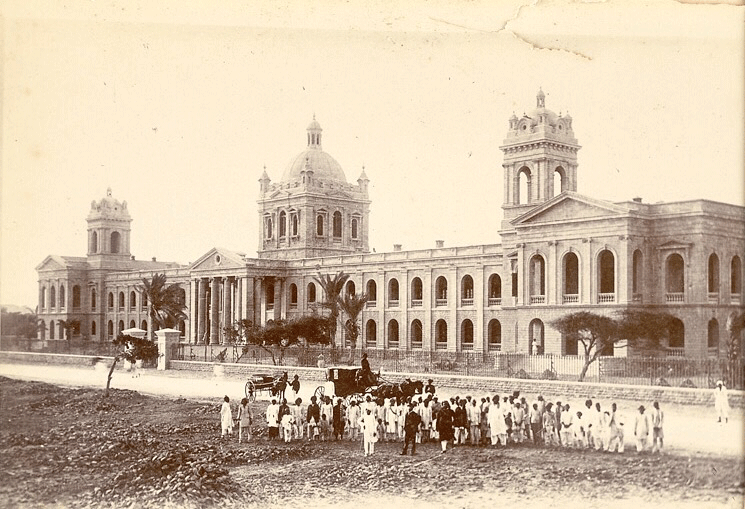
In the heart of Old Karachi: D.J. Science College was established in 1882.
With its close proximity to schools, the site became a host to many of Pakistan’s post-Partition first generation writers, artists, doctors and engineers. As more and more migrants moved into Karachi, the more popular the site grew, with the opening of restaurants such as Café Sadi, art schools, libraries, printing presses and even wrestling dujos – such as the famed Bholu Akhara. Tourists and locals from different ethnicities and backgrounds flocked to the heritage site, coming together for rousing discussions, an exchange of knowledge and a good time.
However, the rapid commercialisation led way to urban blight. The increased economic activity created a massive influx of waste, as there were no proper disposal facilities. Before any efforts were seriously undertaken for the preservation of the heritage sight, the Chowk became a visible indicator of gradual deterioration, with rising mounds of plastic bags, rotting food and red paan streaking the floor, and political slogans and graffiti scrawled liberally along the walls.
The revamped Pakistan Chowk was inaugurated on December 10, 2016, by a founding member of the Pakistan Chowk Initiative, PPP MPA Sharmila Faruqi, and the executor of the Chowk’s conceptual planning and social design, Marvi Mazhar. Marvi spoke of how the mission of rehabilitation was not to beautify the Chowk, rather, it was the need for sustainability. With the backing of Sharmila Faruqi, it took five months to refurbish the monument. From what had become a space for open defecation, drug addicts and waste disposal, the Chowk went through a complete overhaul. The site was given new lamp posts, benches, trash cans and contemporary seating designed to protect the newly planted trees, while providing spots for sitting.

A safe haven: The PCCC offers a safe space for creativity and exchange of dialogue.
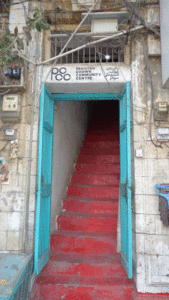 The concept of ‘mohalla saazi’ played a large part in remaking the Chowk. The idea, inspired by Lahore-based architect, Kamil Khan Mumtaz’s ‘mohalla baazi,’ refers to bringing stakeholders together, especially those whose quality of life is directly impacted by cultural heritage and suffer on account of its decay, and exploring avenues to save it. By increasing engagement with those who lived there — interacting with them and developing association with them in relation to activities at the Chowk — the on-going cultivation of accountability and ownership encouraged local residents to start maintaining their neighbourhood. The concept was also worked in to gradually help diminish the sense of helplessness that plagues most communities within Pakistan, especially those in the lower-income bracket.
The concept of ‘mohalla saazi’ played a large part in remaking the Chowk. The idea, inspired by Lahore-based architect, Kamil Khan Mumtaz’s ‘mohalla baazi,’ refers to bringing stakeholders together, especially those whose quality of life is directly impacted by cultural heritage and suffer on account of its decay, and exploring avenues to save it. By increasing engagement with those who lived there — interacting with them and developing association with them in relation to activities at the Chowk — the on-going cultivation of accountability and ownership encouraged local residents to start maintaining their neighbourhood. The concept was also worked in to gradually help diminish the sense of helplessness that plagues most communities within Pakistan, especially those in the lower-income bracket.
After its fruition, ‘Initiative’ was dropped from the name, and the movement evolved into the Pakistan Chowk Community Centre in 2017. A diverse group of young professionals banded together to form a strong Board of Advisors, one that was necessary to ensure the project would meet the objectives it had set out to achieve. All under the age of 40, the board advisors hail from professions in fields of art, medicine, media, film and humanities, and are all established and work in Karachi. A youthful professional board, connecting and working with the younger generation, during and after the project, was more effective.

Maintaining the heritage site is one initiative; it is another task altogether to plan and organise ideas for continued interaction. This is carried out by the PCCC’s ‘cultural manager,’ who, under the mentorship of Marvi Mazhar, is solely responsible for managing events, social media, graphic designs, and content writing for the organisation.
Sabahat Zehra, a Social Sciences graduate from IBA, was the previous cultural manager for the PCCC and an integral part of this campaign – a position that was initially created only on a trial basis. Appointing a fresh graduate – specifically from the humanities field – for the position, created a sustainable model for engaging the youth, by producing a ‘cultural ambassador.’ The PCCC has plans to include more of these young representatives from all backgrounds and regions, which would help them come together to form cultural associations, working for the betterment of the communities they live in.
Mindful of the work necessary to make the initiative fruitful, Sabahat strove to create an all-encompassing atmosphere for every event she managed. When discussing the discrimination against people of non-binary genders and minority groups, Sabahat said: “It’s incredibly important to help them claim space for themselves and make it their own.”
The current cultural manager for PCCC, Saad Rabbani, believes that it is the people of the community themselves that can affirm their own independence and assert the right to their own space, just as they did throughout the rehabilitation process. “It’s evident that it has taken an immense amount of hard work, dedication and the energy of the people living around the Chowk in particular, and in Karachi in general, to convert a small mohalla outreach movement into a vibrant community centre. I think the Pakistan Chowk Community Centre engenders the hope that with the right set of conditions, community engagement can be replicated across Karachi and the rest of Pakistan,” he said.
The PCCC has made sure the venture has an active, visible presence in the print and in the electronic media — from social media platforms, to physical printouts of their newsletter which details their activities, and flyers for upcoming events. Their official website spells out the initiative’s mission in both English and Urdu, and includes sections for upcoming events, and a blog recapping the PCCC’s activities.
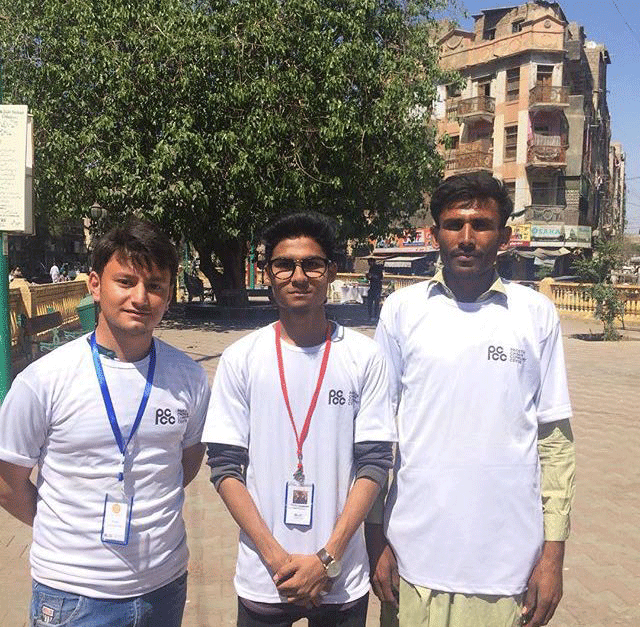
The on-site team: Inaam Razzak (l), Vishal Singhara (c) and Rajaa (r).
It is clear that the initiative was a labour of love. From the concept behind the logo design of the centre – as Pakistan Chowk is also known as Karachi’s printing hub, because of the many printing presses located in the area, the PCCC logo takes inspiration from the way a sheet of paper goes through the cylinders of a printing press and comes out from the other side as print – to each of the new benches being named after heroes of Pakistan (Sabeen Mahmud, Ardeshir Cowasjee, Abdul Sattar and Bilquis Edhi and Perween Rehman, to name a few) the palpable care and effort put into the initiative is clear to all those who frequent the centre.
“To me, the PCCC is a warm place which makes you want to express yourself. The way it engages with the local community makes it a commendable effort,” says Khushbakht Memon, 23, a fresh graduate from SZABIST University and a regular visitor to the centre. “It is a model community centre for all the people in Pakistan who are interested in building inclusive places and for empowering the local community.”
High school student Vishal Singhara, one of the residents keen to work with the PCCC, was taken on as the on-site field coordinator and has since worked to set up countless events at the Centre. While managing music in the PCCC for a ‘Body Movement’ session, where the Aga Khan Girls Scout and Guides Society were taught awareness of movement and dance choreography with rap music, Vishal was so inspired by the performances, he started his own rapping/dance group. Collaborating with the Centre, the position provided him with opportunities to engage in extra-curricular activities he normally would not have thought possible.
The mission of bringing the Chowk back to its former glory without any commercial interference is a three-part project. The first part, mohalla saazi, included an analytical study of the site alongside engaging with the community to make it adaptable. The second part included the designing and implementation of the refurbishment of the Chowk, and the third part included dealing with issues at an urban level while engaging with stakeholders.
With the success the PCCC encountered when invoking traditional routes of extracting data from the community, through interviews and anecdotal charting, the team decided to focus on ghair sarkari tareekh – oral tradition and its validity regarding memory – in collecting their information to curate and document a record of all the heritage sites. The ‘Spoken History Project’ assembles the history of Karachi’s Old Town by gathering storytellers and seeking to archive their memories and exhibiting any memorabilia the team finds.
The PCCC also works on mapping historical structures and heritage sites’ geographical locations, thus compiling data in a tangible document in a visual way. Sarak chaap, as it is called, or the ‘Old Town Mapping’ Project, would be the first record of its kind in Karachi.
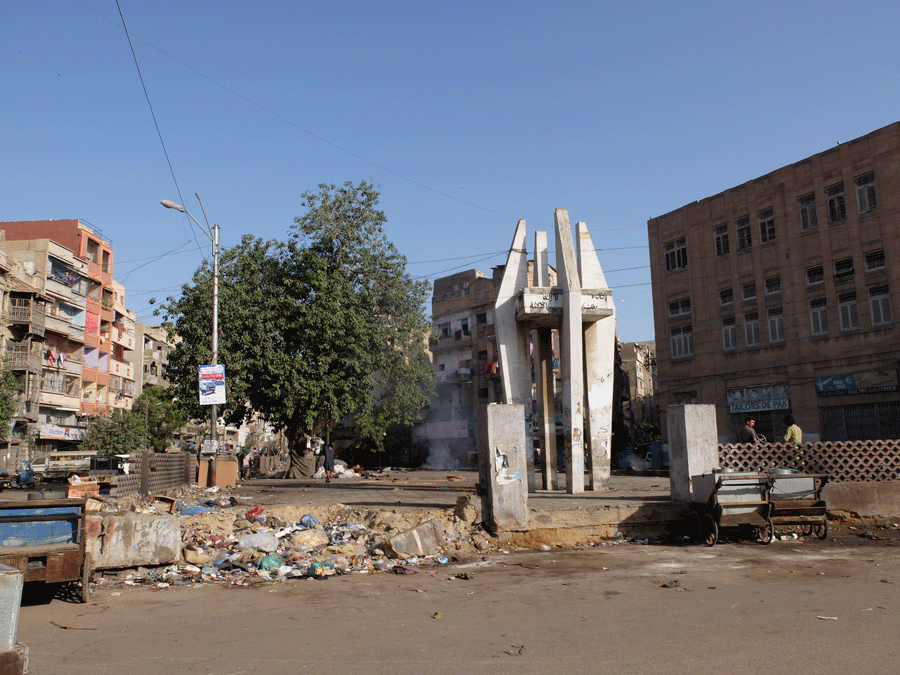
The overhaul: The refurbishment of the Chowk included proper waste disposal, plantation of trees and benches.
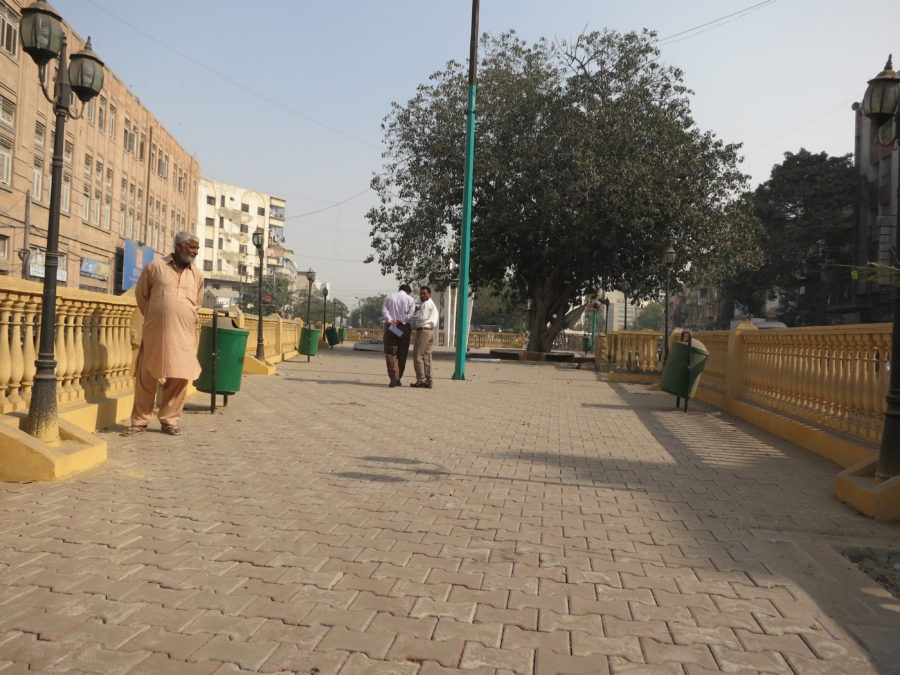
Another is an active academic research project titled, the ‘Heritage Walk Karachi’ (HWK). It comprises three-month sessions which involve people from all around the city, as well as tourists, in walking tours of the Old Town, organised by the Centre, accumulating and recording their feedback and the data at the end of each session through surveys and documenting their oral observations. Alongside holding workshops for educational institutions and customised sessions for individual groups, the HWK encourages its participants to continue contributing any additional information they have mustered or remember regarding the Old Town, to further bolster the HWK’s research. The long-term objective for the HWK, is to have the compiled research taken to governmental and policy-making bodies to formulate plans for neighbourhood intervention and sustainability, rather than embark on the reconstruction of classic historical sites.
The last and most wide-based, is ‘Postervism’ – PCCC’s collaboration with the Renaissance Foundation – a national poster design competition where activism meets design, as participants make posters on different themes based on social issues, in order to raise awareness or portray a certain viewpoint about a cause.
The team for Marvi Mazhar & Associates, her architecture and design studio, sit in a rustic-meets-industrialist-chic workplace, each absorbed in their own tasks. They played a vital role in working to rehabilitate the Chowk, and are currently working on preserving different heritage sites across Karachi. As part of the sarak chaap, in her free time, sitting on a wooden workbench in the middle of the office, Marvi pours over drafts and blueprints of a map not yet charted by Google. “We have all these places in our own city with these amazing names, all of which have a history, and we don’t even know about them!” she says.
With districts that have names like Botal Gali, and the first mistakenly named — now purposefully, on account of its famous food vendors — called ‘Buns Road’ (its original name being Burnes Road) it is no surprise that Pakistan’s unconventional names have rich origins behind them.
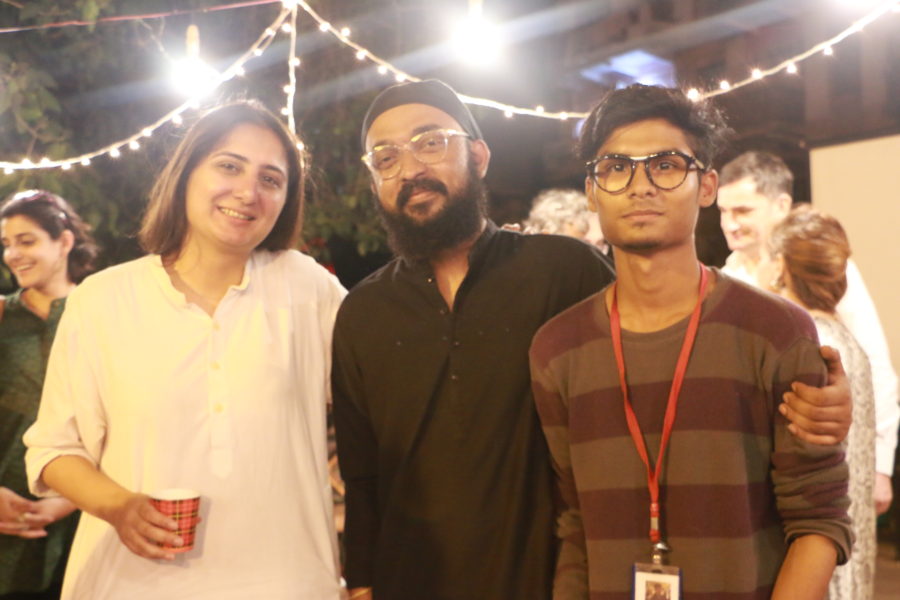
Marvi Mazhar (l), Saad Rabbani (c) and Vishal Singhara (r).
A venture with multiple objectives, the Community Centre focuses on many projects to continue the rehabilitation process and encourage discussion. The PCCC holds regular sessions called ‘The Talking Circle’ to engage with local people in conversations on domestic, political, economic and social issues. For those interested in immersing themselves in the local culture as well as broadening their knowledge of the various branches of arts, the PCCC holds: ‘Palak Jhapak,’ film screenings, workshops, talks and classes on film, acting and theatre; ‘Soch Siyahee,’ the centre’s literary space for celebrating writing, poetry and literature through workshops and discussions; ‘Picture House,’ a way for people from the Old Town to make the most of photography as an art form, and have their work digitised in a photo archive.
The centre also works to help provide legal assistance and health awareness through professionals who practice at the PCCC pro-bono. The lack of resources and ever-present stigma often makes it difficult for people of the Old Town to seek help with regard to domestic issues, financial troubles and mental and physical health problems. The PCCC seeks to impact the health and well-being of the community for the better through its small campaigns and short programmes, and it seems to be working.
When asked of the residents’ reaction to the initiative, Marvi said it was all positive. “It’s really changed things. We have people coming in, talking about their issues, sharing their stories, giving their ideas on how to improve the site. It was all about starting a dialogue that wasn’t an urban narrative, and we succeeded in doing that,” she said.
The PCCC has established itself as a clear case-study of what can happen when a social movement proves successful. Teachers take their students to the Chowk and the Centre to teach them about social movements, activism, design and, above all, the execution of strategising. In spite of its many ongoing projects, the PCCC always has its sights set on new endeavours, and continues to work on formulating realistic plans to implement them. The next site on the shortlist for rehabilitation is a formal sitting space near the Karachi Metropolitan Corporation (KMC) Building, spotted by the HWK during one of the walking tours. “There’s a makeshift chai dhaba under a tree, and all it really needs is to be redesigned,” said Marvi. “We, however, need help and support from the local government of the South District.” She went on to note that the lack of facilitation by governing bodies can lead to difficulties in acquiring resources, and carrying out the rehabilitation process.
Despite the shortcomings, however, by collaborating on workshops, classes and talks with organisations like the Alliance Francaise, the Indus Valley School of Art and Architecture, IAMKHI, ArtChowk, Girls at Dhabas and the Sub Rang Society, the PCCC has established itself as a powerful champion of the environment, heritage, culture and community, battling urban decay in multiple ways. There is no doubt that under the helm of strong, determined activists, the PCCC will remain a beacon for positive, sustainable regeneration of the city, of the ethos of community, and of history.


